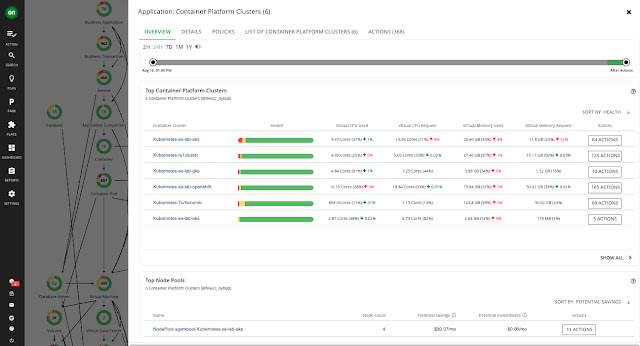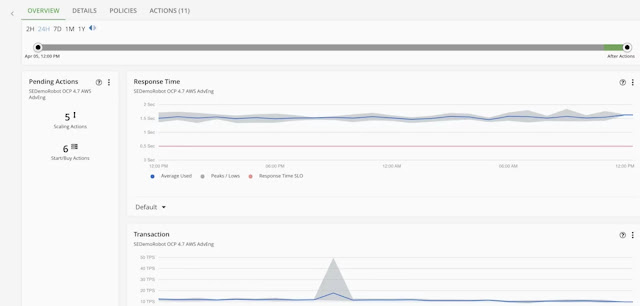The race to innovate has likely left you (and many, many others) with unexpectedly high cloud bills and/or underutilized resources. In fact, according to Flexera’s 2023 State of the Cloud report, for the first time in a decade, “managing cloud spend” (82%) surpassed “security” (79%) to become the number one challenge facing organizations across the board.
We get it. Overprovisioning is the go-to strategy for avoiding performance risks.
Trying to find the balance between performance and efficiency is anything but a walk in the park. Sure, there are endless Kubernetes cost monitoring tools available that allow you to keep tabs on various aspects of your cluster’s resource usage, like CPU, memory, storage and network. Tracking these metrics can help identify resource-intensive workloads, inefficient resource allocation or unnecessary resource consumption that may lead to increased costs.
All this time-consuming monitoring is closely followed by the labor-intensive work of rightsizing containers and setting auto-scaling policies and thresholds.
Hello, automation
IBM Turbonomic optimizes your Kubernetes environment through container rightsizing, pod suspension and provisioning, pod moves and cluster scaling actions. Every layer of the stack is analyzed and resourced based on real-time demand—from pods and services to containers to nodes, as well as the underlying cloud infrastructure. It’s purpose-built to help your teams automate and quickly achieve significant and continuous results.
Turbonomic supports all upstream versions of Kubernetes—Red Hat OpenShift, EKS, AKS, GKE and more—on any cloud, in any data center and with any hybrid or multicloud combination. It understands the resource needs of your applications and continuously determines the actions that ensure the apps get exactly what they need to perform.
Let’s begin by looking at your container clusters.
Here you see your top clusters sorted by health, followed by top node pools sorted by potential savings. This dashboard provides a great overview of what you want to keep an eye on, but let’s take a look at what really matters—the actions.
In this example, we see an action to resize a workload controller (a container). As the action shows, resizing here will improve performance. With Turbonomic, every action includes the data to back it up, as well as details around the action’s impact.
In this next example, we see an action to suspend a node, which will improve efficiency. By how much, you ask?
Look at how much is saved just by suspending this one unused node.
Still, it can be unnerving for application owners and development teams to scale back resources. We get it. Performance is paramount.
Turbonomic is all about performance
Turbonomic makes sure your apps get exactly what they need when they need it. The efficiency gains are a byproduct of that.
Have your app owner take it. It’s a low-risk way to get comfortable with automation. In fact, some of these actions are non-disruptive and reversible.
Again, because every action also comes with metrics and the reasoning behind it, teams have an easier time trusting the decision to act. You need that trust in order to move from human decision-making to operationalizing automation.
An observability platform’s best friend
If you have application data from critical tools like IBM Instana Observability or any other application performance monitoring (APM) solution, Turbonomic can understand the response time and transactions of the application, stitching this application data to the Kubernetes platform and the infrastructure on which it runs.
You and everyone else see exactly how dynamic resourcing improves application performance while minimizing cost.
See here—even as demand fluctuates, response times are kept low.
If you have predefined service level objectives (SLOs), Turbonomic can ingest that data to dynamically scale microservice applications out and back based on demand to ensure those SLOs are always met. SLO policies can also be configured directly on the platform.
You can gradually take more and more actions, then integrate them with your pipelines and processes. Whether it’s Slack, GitOps, TerraForm, Ansible, ServiceNow or others, Turbonomic’s got you covered.
Feel free to start with small steps to get started, but unlocking Kubernetes elasticity for continuous performance at the lowest cost requires automation.
Let IBM Turbonomic handle it
With Turbonomic, you can automate these micro-improvements at a rate that exceeds human scale. Remove the labor-intensive work of rightsizing containers and setting auto-scaling policies and thresholds and let the software do it for you based on real-time application demand. The cumulative effect of these micro-improvements is Kubernetes applications that perform exactly like they should at the lowest cost possible.
In other words, put those performance-risk nightmares to bed.
Source: ibm.com











0 comments:
Post a Comment